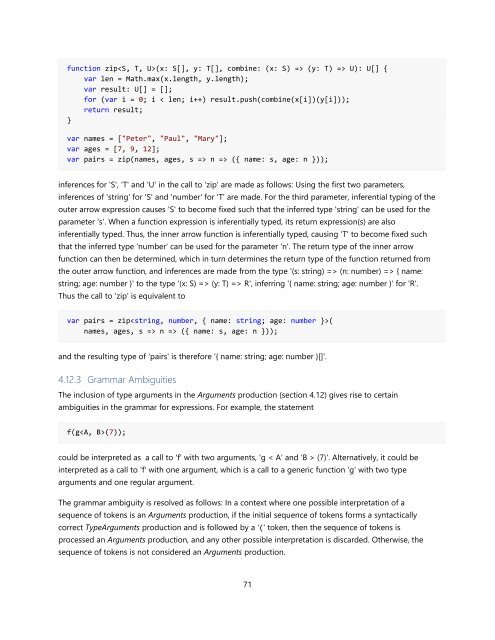TypeScript Language Specification v1.5
TypeScript Language Specification v1.5
TypeScript Language Specification v1.5
Create successful ePaper yourself
Turn your PDF publications into a flip-book with our unique Google optimized e-Paper software.
function zip(x: S[], y: T[], combine: (x: S) => (y: T) => U): U[] {<br />
var len = Math.max(x.length, y.length);<br />
var result: U[] = [];<br />
for (var i = 0; i < len; i++) result.push(combine(x[i])(y[i]));<br />
return result;<br />
}<br />
var names = ["Peter", "Paul", "Mary"];<br />
var ages = [7, 9, 12];<br />
var pairs = zip(names, ages, s => n => ({ name: s, age: n }));<br />
inferences for 'S', 'T' and 'U' in the call to 'zip' are made as follows: Using the first two parameters,<br />
inferences of 'string' for 'S' and 'number' for 'T' are made. For the third parameter, inferential typing of the<br />
outer arrow expression causes 'S' to become fixed such that the inferred type 'string' can be used for the<br />
parameter 's'. When a function expression is inferentially typed, its return expression(s) are also<br />
inferentially typed. Thus, the inner arrow function is inferentially typed, causing 'T' to become fixed such<br />
that the inferred type 'number' can be used for the parameter 'n'. The return type of the inner arrow<br />
function can then be determined, which in turn determines the return type of the function returned from<br />
the outer arrow function, and inferences are made from the type '(s: string) => (n: number) => { name:<br />
string; age: number }' to the type '(x: S) => (y: T) => R', inferring '{ name: string; age: number }' for 'R'.<br />
Thus the call to 'zip' is equivalent to<br />
var pairs = zip(<br />
names, ages, s => n => ({ name: s, age: n }));<br />
and the resulting type of 'pairs' is therefore '{ name: string; age: number }[]'.<br />
4.12.3 Grammar Ambiguities<br />
The inclusion of type arguments in the Arguments production (section 4.12) gives rise to certain<br />
ambiguities in the grammar for expressions. For example, the statement<br />
f(g(7));<br />
could be interpreted as a call to 'f' with two arguments, 'g < A' and 'B > (7)'. Alternatively, it could be<br />
interpreted as a call to 'f' with one argument, which is a call to a generic function 'g' with two type<br />
arguments and one regular argument.<br />
The grammar ambiguity is resolved as follows: In a context where one possible interpretation of a<br />
sequence of tokens is an Arguments production, if the initial sequence of tokens forms a syntactically<br />
correct TypeArguments production and is followed by a '(' token, then the sequence of tokens is<br />
processed an Arguments production, and any other possible interpretation is discarded. Otherwise, the<br />
sequence of tokens is not considered an Arguments production.<br />
71


















